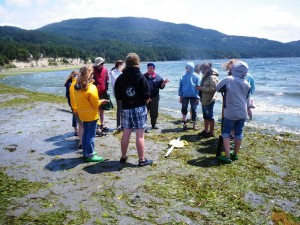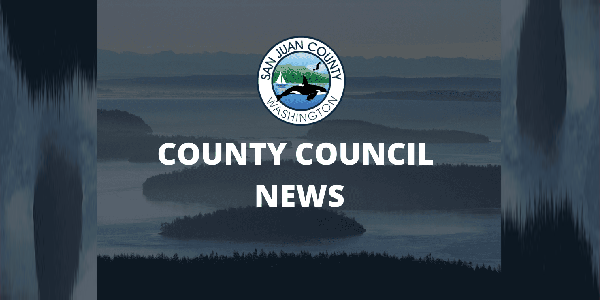The Indian Island Marine Health Observatory celebrates its second year of research and presents its first annual Report to the Community on Thursday, October 28. Everyone is invited to this free event beginning at 5:30 p.m. at the Madrona Room of the Orcas Center.
Russell Barsh, founder of Kwiáht, the Center for the Historical Ecology of the Salish Sea, says the Report to the Community will give Orcas Islanders a first-person view of the last two years’ work at the [intlink id=”8482″ type=”post”]Indian Island Marine Health Observatory [/intlink]in Eastsound.
Indian Island, a low-tide’s walk from the village of Eastsound, is the first of three sites that will become invaluable marine science observatories in the San Juan Islands. Indian Island, owned by the Bureau of Land Management (BLM), is the initial observatory, with plans for similar studies to be conducted at the Friday Harbor Marina on San Juan Island and Fisherman’s Bay on Lopez Island.
Barsh says, ” Here’s what we know now; it’s mostly good news; there are so many really cool animals; more than we imagined. There’s a lot of life in bay, and a huge abundance of clams. The chemical contamination and effects from storm sewer system have not reached the point of damage.”
Barsh anticipates telling the public of the work to establish a baseline of the marine health in East Sound waters, which will:
- “give a green light to shellfish safety, which has been a historic food supply, and
- establish some control over contamination.”
While more restrictions may be put on the island, Barsh notes that the public has been “protective” of East Sound’s and Indian Island’s marine health. There was voluntary compliance and public support this past summer as Beach Watchers and other community scientists asked Indian Island visitors to preserve the nesting oystercatchers’ privacy. While two complaints were registered, most of the public “responded to the advisory saying, ‘Oh cool,’ “Russel reports.
Moving forward, Barsh sees that restriction on Indian Island may include “development that puts all feet in one place — perhaps establishing a trail on the island noting more sensitive off-trail areas,” says Barsh. Such off-trail areas may include where birds are nesting or rare plants are flowering.
Whether the on-going revision of the storm sewer works in limiting chemical input into the bay remains to be seen, Barsh says. For now, “We’re seeing incredible diversity; there’s lots to take pride in.”
Kwiáht. In the Coast Salish language of Puget Sound, “Kwiáht” means “a spiritually clean place.” Kwiáht’s Articles define its twofold mission as:
- scientific research in the service of good stewardship of cultural and biological resources in the San Juan and Gulf Islands,
- the improvement of local science education
Other organizations participating with Kwiáht in the Indian Island Marine Health Observatory are the Washington State University (WSU) Extension Beach Watchers, San Juan Nature Institute, U.S. Bureau of Land Management, San Juan County Land Bank, San Juan County Parks, Orcas Island School District, Salmonberry School and Orcas Christian School.
In addition to the research report, Thursday’s program at the Orcas Center includes a slide show of the amazing fish, nudibranchia and other marine creatures of Indian Island. Participants can get a sneak peek of the new Field Guide to the Marine Life of Indian Island, a unique publication site-specific to the Eastsound inter-tidal zone.
Meet the Beach Watcher volunteers, neighbors and other collaborators who are committed to making the health of Indian Island a reality — and consider joining in the effort.
Orcas Elementary 4th and 5th graders will compete in a marine-themed costume contest and Sharon Abreu will sing an original composition. A light supper has been catered by the Orcas Village Store.
The free event starts at 5:30 p.m.
(More information about the Indian Island Marine Observatory is available at www.indianisland.info)
Report to the Community on Indian Island will give Orcas Islanders a first-person view two years’ work. Here’s what we know now
It’s mostly good news, really cool animals, more than imagined… lot of life in bay
Chemical contamination and effects from storm sewer system not reached point of damamge
Talking with public
Work re establishing a baseline
1) green light to shellfish safety, huge abundance of clams, historic food supply
2) establish some control over contamination
Moving forward, being careful about chemicals used in town.
Public protective responding to information cooperatively
More restriction on island, owned by BLM
Voluntary compliance. Public supportive this past summer as BeachWatchers and other community scientists asked to preserve the oystercatchers’ privacy. While two complaints were registered, most of the public responded to the advisory with “Oh cool.”
Future
“Development that puts all feet in one place. Perhaps establish a trail on the island noting more sensitive off-trail areas – such as nesting birds or flowering of rare plants.
Whether the revision of the stormsewer works in limiting chemical input into the bay
Huge abundance of clams
New marine guide for Indian Island, showing some 50 species of marine wildlife
We’re seeing incredible diversity; there’s lots to take pride in.”
**If you are reading theOrcasonian for free, thank your fellow islanders. If you would like to support theOrcasonian CLICK HERE to set your modestly-priced, voluntary subscription. Otherwise, no worries; we’re happy to share with you.**








